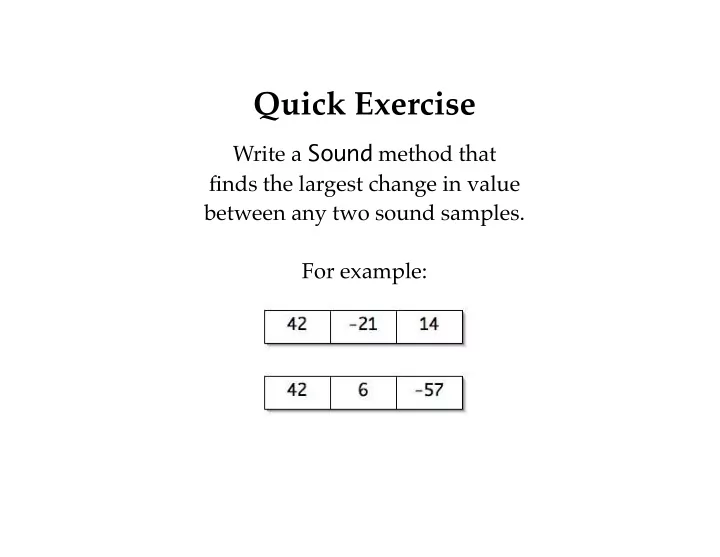

Quick Exercise Write a Sound method that finds the largest change in value between any two sound samples. For example:
Sound Encodings Consider a typical pop song, "Sweet Dreams (Are Made of This)", by the Eurythmics. > sweetDreams.getLength() 9436032 Each sample requires 2 bytes, so encoding the song requires 18,872,064 bytes .
Sound Encodings — Better? The song, stored as an .aiff file, actually takes up about twice that amount on my hard drive: 37,746,414 bytes . Sounds encoded as a .wav file requires a similar amount of space: 37,744,172 bytes . How can I fit more songs on my iPod??
Data Compression Often we can find a way to store the same amount of information in less space — with a different encoding .
Data Compression: MP3 MP3 is an especially efficient encoding. "Sweet Dreams" as an .mp3 file takes only 4,281,625 bytes . (about 11%)
Going Back? Most compressions are easily manipulated only in specific way. (MP3 encoding is great for playing, and not much else.) Can we go backwards, and retrieve our original source file?
Data Decompression: MP3 With MP3, no. The source of its size efficiency is loss of information .
Lossy versus Lossless Compression A compression algorithm that loses information is called lossy . A compression algorithm that retains all information is called lossless . Lossy algorithms can generate smaller files, at some cost in the quality of the file for some purposes — including decompression.
Designing a Compression Algorithm Our Sound objects use 2 bytes for each sample value. This gives a range of values of [-32768..32767]. But many sounds have sample-to-sample ranges that are much smaller.
Designing a Compression Algorithm Instead of using 2 bytes for each sample value, we could use 1 byte to record each sample change! This encoding uses 7 bytes instead of 12 bytes for this example.
Our Compression Algorithm Instead of using 2 bytes for each sample value, we could use 1 byte to record each sample change. For a Sound of size n , how many bytes will our encoding use? Is the algorithm lossy or lossless?
An Exercise in Compression Write a Sound method that returns an array of the differences in value between each sound sample. Your array will be getLength()-1 bytes long. public int[] arrayOfDifferences() { int[] differences = new int[ getLength()-1 ]; // fill in the blank return differences; }
Recommend
More recommend